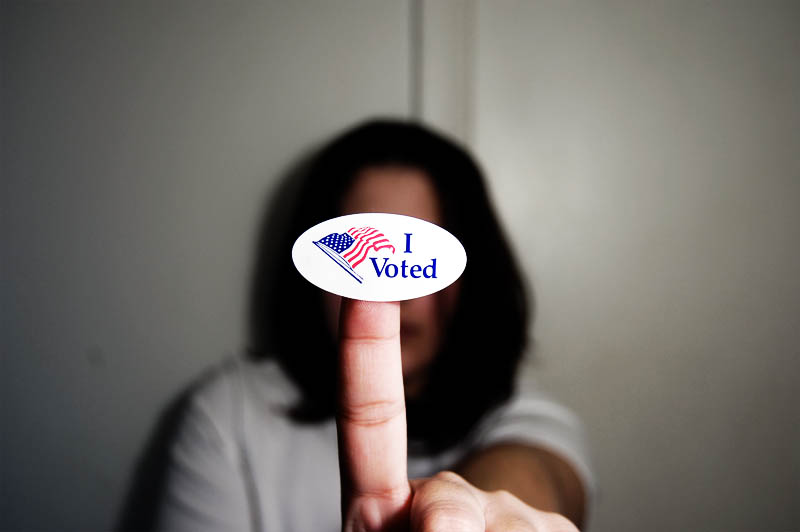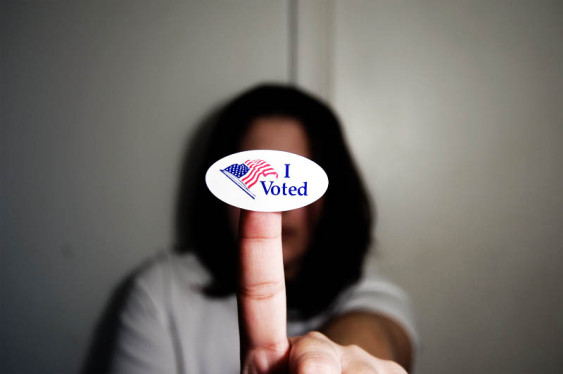Last week we showed that, by holding city elections in low-turnout odd-years, Seattle disproportionately disenfranchises people of color in Seattle. But zooming out, the data shows voters in every election are older and whiter than Seattle’s voting age population. People of color and younger people are not having their fair say in elections. This could be because people of color and younger people are in the minority, and those in the minority often get zero representation in the current winner-take-all voting system. When voters in the minority see that their voice can be heard, for example in a proportionally elected city council, they are more likely to participate. To encourage all citizens to vote, Seattle could switch to a system like proportional representation that makes it more likely their votes will matter, even if they are in the minority like young people and people of color.
Seattle voters are overwhelmingly White in every election
The graph below shows that in most elections, only around 10 percent of Seattle voters are African American, Asian American, or Latinx, and their share of voters bumps up to about 13 percent during presidential year general elections.

Original Sightline Institute graphic, available under our free use policy.
People of color are punching below their electoral weight in Seattle
According to Census and American Community Survey data, African Americans, Latinxs, and Asian Americans together make up about 27 percent of Seattle’s voting age population. On the one hand the census might undercount people of color so their percentage is actually higher, but on the other hand some of those adults might not be registered or eligible to vote. Either way, people of color make up more than 25 percent of voting age adults in Seattle but only 10 percent of voters in primaries and odd-year city elections and only about 13 percent of voters in presidential-year general elections. They are not getting their fair share of say in elections. Possibly because they don’t think voting would get them their fair say in the current winner-take-all system.

Original Sightline Institute graphic, available under our free use policy.
Younger people are punching below their electoral weight in Seattle
Younger voters in Seattle are also not getting their fair voice in elections. Seattle’s voting age population is relatively young—nearly 40 percent are under 35 and only 13 percent are older than 65. But primary voters are old—most are 50 and older, and more than one-quarter are 65 and older. Odd-year general election voters, the voters that choose the city’s leadership, aren’t much younger—half are over 50 and only 21 percent are under 35.

Original Sightline Institute graphic, available under our free use policy.
Younger people and people of color have less say in Seattle elections
In Seattle, as in most places in Cascadia, younger people and people of color are punching below their weight in elections. Other US cities’ experiences with semi-proportional voting suggest that people of color come out to vote in greater numbers when they feel the electoral system gives them a fair shot at representation. To give all residents an equal say in who runs city hall, Seattle could switch to a proportional representation electoral method that would ensure more voters have more say in who gets elected.
Notes on Methodology
The race and ethnicity data comes from the Voter Activation Network VoteBuilder database which uses first, middle, and last name as well as the demographics of the precinct to estimate each voters’ race and ethnicity. The database might under-identify people of color if they have names that are commonly White. It could be that more voters are people of color than the database identifies.










Soccer Fan
Are they not being mailed ballots? I still don’t understand why you’re suggesting disenfranchisement. The real question to ask and aswer here is what are the drivers to low rates of voting. Cloaking that in terms like “denying them their say” or “disenfranchisement” is innacurate and disingenuous. One’s voice is heard and represented when one votes. I don’t understand why we’d create a new way of voting to account for people who can’t be bothered to exercise the basic right of citizenship in our country: voting.
RDPence
Headline in your email alert reads “Many young people and people of color don’t see the point of voting in Seattle”, so naturally I was looking for quotes from young voters and people of color, or their advocates, to substantiate this claim. Let them explain their lack of participation in city elections. But I found no such information, only the author’s conjecture, a white woman living in Portland.
On another point, Seattle and other local governments do not determine when they hold their elections. That is mandated in state law, legislation passed back about 1963. The point was that even-year elections were for partisan, for national and state offices, and odd-year elections were for the mostly non-partisan local government elections. Piling all that voting into even-year elections could result in voter overload — our ballots are already long; do we really want to double their length? (We’re not like Canada and the UK, where most of their ballots consist of only one office, for their local MP or MLA.)
Jennifer franklin
I truly appreciate the intent to ensure representation for currently underrepresented groups, but once any gerrymandering is off the table and everyone who registers gets a ballot by mail, the proposal assumes one can reliably generalize from voters in a group to represent the views of nonvoting folks of the same group.
If districts are drawn fairly, the emphasis should be on turning out the vote by making voting easier in whatever way is reasonable , not on making voting unnecessary for full representation. Otherwise, the risk is for very ‘unrepresentative’ activists who are a minority in their community to have incentive to suppress the votes of others and essentially be functionally overrepresented. Does that make sense or did I miss the point?
Elaine
As the old saying goes, “if you don’t vote, then don’t bitch.” Could the youngest voters be lazy?
Sarajane Siegfriedt
The author fails to acknowledge the effect that Seattle’s (and Yakima’s) change to District voting for city council has had on representation of minorities in our respective city councils. Three Latinas were elected in Yakima the first time they elected by districts. As of November, Seattle has five of nine Councilmembers of color. Evidently these candidates were not enough to inspire young people and people of color to vote proportionally. Perhaps Sightline is addressing the wrong problem. An in-depth study of voter motivation and participation by age (in particular) is needed, because that is one barrier that cannot be removed. My experience in doorbelling to get out the vote is that college-age young people rarely are living at their parent’s address, so they are not receiving their ballots where they live.
Many young people do not buy stamps, so ballot drop box locations have been
increased, and their use has increased substantially. The Voting Rights bill in the Legislature is likely to mandate local elections by district, to address local housing segregation, increasing representation by people of color. Another bill would register young people automatically when they get a drivers license, effective when they turn 18.
Bottom line: on the subject of voting, Sightline should use local writers.